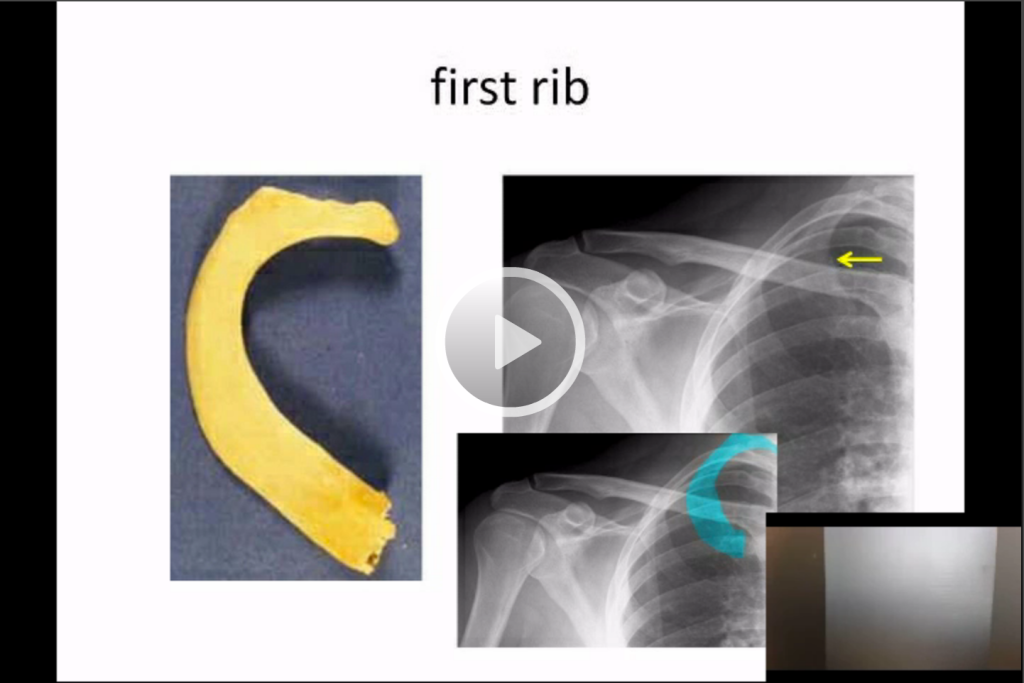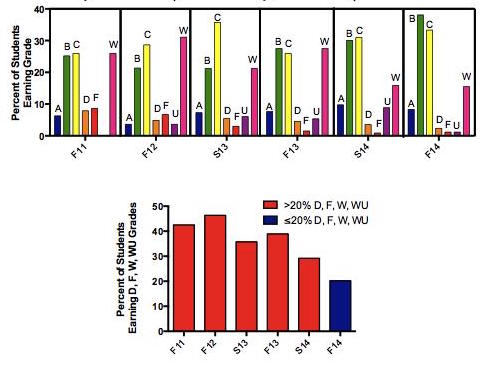Two weeks ago Michael and I posted an third article on EdSurge that described an encouraging course redesign for STEM gateway courses.
In our e-Literate TV series on personalized learning, we heard several first-hand stories about the power of simple and timely feedback. As described in the New York Times, administrators at the University of California, Davis, became interested in redesigning introductory biology and chemistry courses, because most of the 45 percent of students who dropped out of STEM programs did so by the middle of their second year. These students are the ones who typically take large lecture courses.
The team involved in the course-redesign projects wanted students to both receive more individual attention and to take more responsibility for their learning. To accomplish these goals, the team employed personalized learning practices as a way of making room for more active learning in the classroom. Students used software-based homework to experience much of the content that had previously been delivered in lectures. Faculty redesigned their lecture periods to become interactive discussions.
The UC Davis team focused first on redesigning the lab sections to move away from content delivery (TAs lecturing) to interactive sessions where students came to class prepared and then engaged in the material through group discussions (read the full EdSurge article for more context). In the UC Davis case, this interactive approach was based on three feedback loops:
- Immediate Feedback: The software provides tutoring and “immediate response to whether I push a button” as students work through problems, prior to class.
- Targeted Lecture and Discussion: The basic analytics showing how students have done on the pre-lab questions allows the TA to target lecture and discussion in a more personal manner—based on what the specific students in that particular section need. “I see the questions that most of my class had a difficulty with, and then I cover that in the next discussion,” Fox says.
- Guidance: The TA “would go over the answers in discussion.” This occurs both as she leads an interactive discussion with all students in the discussion section and as she provides individual guidance to students who need that help.
The opportunity to make the lab sections truly interactive, and not just one-way content delivery through lectures, is not unique to the UC Davis example. Shortly after publishing the article, I found another course redesign that plays on some of the same themes. This effort at Cal State Long Beach (CSULB) was described in the Press-Telegram article:
Sitting near a skeleton in a Cal State Long Beach classroom last week, Professor Kelly Young dissected a course redesign that transformed a class from a notorious stumbling block to a stepping stone toward graduation.
Young has reduced the number of students failing, withdrawing or performing below average in Bio 208: Human Anatomy from 50 percent to fewer than 20 percent in about four years, and poorly performing students have watched their grades climb, with continued improvement on the horizon.
That statistic is worth exploring, especially when considering that 500-600 students take this class each year at CSULB.
Thanks to the CSULB Course Redesign work, this work in Bio 208 has some very useful documentation available on the MERLOT repository. Like the UC Davis team, the CSULB team first redesigned the lab sections, “flipping them” to enable a more personalized approach within the small sections. Unlike UC Davis, CSULB centered the content on videos and podcasts.
While we have been working on refining the lecture over the past several years, the Redesign Project has allowed us to get serious about redesigning the laboratory (the source of low grades for most of the students). During the semester, students learn over 1,500 structures just in the laboratory portion of the course. Despite asking them to look at the material before class, students would routinely come to the laboratory session totally unprepared. Flipping the class was an enticing solution to increase preparedness- and therefore success.
After trial and error over a few years, the team has created a series of “Anatomy on Demand” annotated videos. But as the team pointed out, this is not the actual important factor.
While the videos often get attention in a flipped classroom proposal, the true focus of our project is what we do with the newly-created class time in the laboratory provided by flipping the lectures. The most important aspect of this project is our new interactive laboratory sessions that serve to deepen understanding of the material. The idea is that a student will watch the relevant short videos (usually 5-7 per week) prior to coming to the laboratory, arrive prepared to their laboratory, take a short quiz that is reduced in rigor but assures readiness, and then spend at least two hours in the laboratory exploring the structures in detail at interactive small group stations.
The effect has been that students are moving from receiving introductions to material and now participating in critical thinking in the lab.
This new method allows prepared students to deeply interact with the material, as opposed to merely being introduced to it. In previous years, we hoped to have students leave the laboratory with some rote memorization of the structures complete. In contrast, when students arrive with a basic understanding of the structures, we are able to use laboratory time to ask application and critical thinking questions.
After applying multiple redesign elements and interventions, the CSULB team started seeing impressive results, especially starting in Spring 2014. This is where they are tracking the reduction in percentage of students getting D, F, or Withdraw from almost 50% to approximately 20%.
Both of these course redesigns were led by university faculty and staff and are showing impressive results. Not just in grades but in deeper student learning. Kudos to both the UC Davis team and the CSULB team.



I am a bit dismayed that while you mention the results from my colleagues in biology here at CSULB, you are unaware of the work my faculty and I have done in physics. The CRT projects housed in my department comprise the first two fully online physical science with laboratory courses in the CSU system, and we find superior content and affect results compared to our brick and mortar courses. Importantly, our courses exhibit no bottlenecks, and no achievement gaps in outcomes for minorities or females. AND the CRT project is a part of a seamless program redesign which has resulted in our degrees awarded annually increading by a factor of 10 between 2007 and now. Biology is early on in this process, with success in particular courses … but our department shows what the endgame looks like if we are serious about program redesign.
Look us up on merlot.